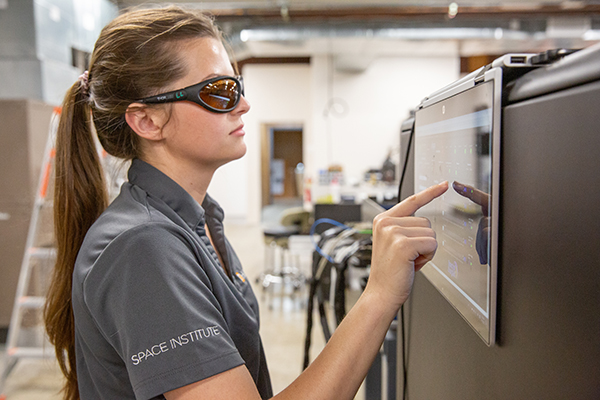 By Randall Brown. Photography Jessica Tezak.
By Randall Brown. Photography Jessica Tezak.
Ask Lauren Lester about the weather and the conversation might escalate quickly—hypersonically, even.
Lester studies the effects of weather on hypersonic aircraft as a graduate research assistant with the High-Speed Original Research and Innovation Zone (HORIZON) research group at UTSI, advised by Professor Phillip Kreth. It isn’t a field she might have dreamed of in her early years, but the pursuit of mechanical and aerospace engineering appealed to a bigger picture for her.
“I never was five years old thinking, ‘I’m going to be an engineer,’” said Lester. “I think when it came down to the decision to be an engineer, it was more of, ‘I want a challenge, and I want to continually be challenged.’”
Lester was also drawn to the opportunity to help create positive impact on a large scale.
“The aerospace sector has the ability and a necessity to design state-of the-art technology that eventually can be seen in every other field,” she said, “from medical equipment to the GPS on your phone and even Tang, the drink.”
Lester, originally from Millington, Tennessee, near Memphis, is in her fourth year at UTSI, working toward her PhD. She completed her undergraduate studies in mechanical engineering at UT Knoxville, where she served as a MABE student representative on the WomEngineering Leadership Council and was the president of UT’s chapter of the American Institute of Aeronautics and Astronautics.
Through AIAA, she learned of the opportunities at UTSI.
“I had no idea this place even existed,” she said. “But through the AIAA group at UTK, we planned a special trip out here to take a tour of the Arnold Engineering Development Complex and UTSI. I met Professor John Schmisseur, HORIZON founder. He offered me an internship, and the rest is history.”
With HORIZON, Lester simulates weather effects to improve the performance and longevity of high-speed aircraft. Using UTSI’s Mach 4 wind tunnel, she examines the in-flight impact of rain, sleet, snow, sand, dust, and other factors such as shock waves and shock wave boundary layer interactions—created by the interaction of shocks formed by protruding aircraft elements and a viscous shear layer on the surface of the craft through which the forces of flight are transferred to the vehicle.
“Aircraft have seen a large amount of damage from them,” said Lester. “It’s going to be the equivalent of a jackhammer to the surface of your vehicle if they’re not mitigated properly.”
Her questions come down to examining how flying through rain affects a hypersonic aircraft and the implications for designing aircraft to maintain peak performance.
“If a rain droplet was to walk through a shock wave at a specific frequency, does it have the ability to dramatically alter this flow feature?” asked Lester. “I take a laser and focus that down to induce plasma. The plasma will dissipate and we’re left with a useful thermal spot that can convect downstream and works as a rain droplet simulator.”
Her investigative efforts earned her first place in the 2021 Wu Student Presentation Competition at UTSI, an award that comes with a grant to help fund future endeavors. Her next step is completing her PhD, a milestone she hadn’t always planned on.
“I came in wanting my master’s and never thought I would get a PhD,” said Lester. “I had my professors telling me, ‘You could actually do this thing—you could actually make it through.’”
She is grateful to them for helping motivate her ever forward. The foundation of her UT experience has her looking ahead with confidence to a career in hypersonics.
“I was lucky to have their support. It came down to realizing I was thriving here,” said Lester. “And if you have a good thing, run with it.”